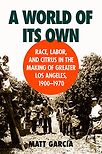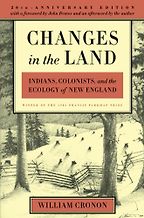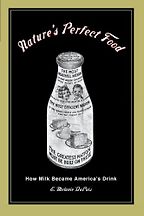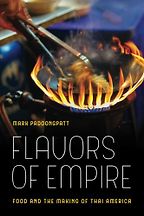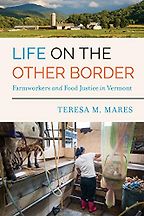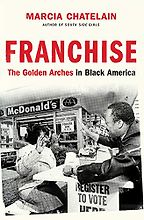Food studies is an academic field that has been growing since the late 1970s. Before we discuss your books, if you had to describe the discipline for your university’s prospectus, what would you write?
Food studies examines what food tells us about the past and present of civilization. Exploring how food is produced, prepared and consumed teaches us much about a particular society.
“Producers of the ingredients get left out of the story, particularly the people that are working at the level of raw materials, tending and picking crops”
Food production, and workers, have been left out of food studies for too long. That’s something I’ve written about in The Journal of American History. Studying cuisine can tell us a lot about our history, as Rachel Laudan showed in her Cuisine and Empire. But what often happens in such studies is the fetishization of the preparer or chef while the producers of the ingredients get left out of the story, particularly the people that are working at the level of raw materials, tending and picking crops. My focus is on where food comes from; that’s not necessarily a very popular approach. Some folks think that that is agricultural history or labor history. I just disagree.
What caused food studies to cleave from the more general field of cultural history?
Food appeals to people beyond the academy. Consider the popularity of Michael Pollan and Eric Schlosser. Food has currency in our culture; that currency enables historians to tell a story about our society that would be more difficult to tell through other materials. So I think food studies cleaved away from cultural studies, because it is a topic that engages students and people outside of the academy. It’s a gateway that leads to a variety of issues, such as race, labor, and colonialism, and it draws so many people in.
How food history helps create a deeper understanding of the exploitation inherent in the links of the food chain from farm to table is apparent in your work, so before we get to your books choices I wanted to talk about two of your own books. First, tell us about A World of Its Own: Race, Labor, and Citrus in the Making of Greater Los Angeles, which is a look at agriculture from the bottom up.
I grew up seeing the world through the prism of food. My family were the workers who picked the fruit and prepared meals in California. My grandmother worked for Claremont College food services for 63 years. When I started in the profession, in the mid-1990s, farm workers and food preparers, many of them Latino, were left out of these histories.
“The labor of Latinos was essential to the making of modern Los Angeles”
Writing this book was one way to change that. The labor of Latinos was essential to the making of modern Los Angeles. When people think of LA, they think of the film history. But what made the city is agriculture—citrus cultivation in particular. And at the roots of agriculture are not just the growers that invested in citrus groves, but also the workers that harvested the produce. The workers reaped, with their hands, the wealth of the groves for the growers and society.
You look at food history from the labor organizer’s perspective in From the Jaws of Victory: The Triumph and Tragedy of Cesar Chavez and the Farm Worker Movement. Give us a précis please.
After focusing on the workers who were at the bottom of this food pyramid—workers who were hidden in earlier histories and who remain some of the most downtrodden people in our society—I turned towards the folks who came out of the fields to bring justice to farm workers. This book is about the formation of the United Farm Workers union of the sixties and seventies and the leadership of Cesar Chavez. It asks: why is there still so much injustice in the food system despite the efforts of this organization and this man?
How do food workers fit into the labor movement?
Industrial laborers and industrial unions have been privileged over agricultural laborers and agricultural unions. Governments discriminate against agricultural workers versus industrial workers. For instance, in the United States, the National Labor Relations Act, which was a part of the New Deal, left out agricultural workers from having the right to collective bargaining. To this day, agricultural workers lack the right to organize. And they were not alone. People who do domestic service work, who are mostly women and increasingly women of color and immigrants, were also left out of this legislation. That bias against farm workers goes back all the way to the New Deal and continues today.
On to the books you’ve chosen, starting with William Cronon’s Changes in the Land.
I use Cronon in my food history class at Dartmouth because I want students to understand that choices were made prior to and during European colonial settlement, about how to extract sustenance from the land. Those choices were driven by cultural practices and social relations. Cronon contrasts the ways that Native Americans used the land, taking what it would give, with the way colonists used the land, trying to force it to yield what they wanted. Native Americans migrated with the seasons and did not try to engage in agriculture in inhospitable places, such as Northern New England. English colonists attempted to impose their way of producing food in this same place. The consequences of their choices were problematic to the inhabitants and to the health of the land. It’s a wonderful study, over a long period of time, focused on two cultures and the different ways in which they use that land.
Changes in the Land is traditionally considered a landmark in environmental history, but you’ve named it among your five about food history.
Many see Cronon’s book as ecological studies or environmental history. But what I see is his study of the consequences of raising livestock on the land, the consequences of extracting food from a place. Changes in the land, environmental changes, happen for a reason. The reason behind the changes in the land as a consequence of colonialism was the commodification of the land’s yields. Cronon makes this point so well in another book of his, Nature’s Metropolis. But in this first book, he also makes clear that livestock agricultural practices, food production practices, have consequences.
Milk is Melanie DuPuis’s touchpoint in her book, Nature’s Perfect Food. Why have you chosen it?
Melanie DuPuis does a great job of telling how milk came to be seen as central to the American diet. Milk has an amazing cultural apparatus around it. In the United States, most people would recognize the key elements of the milk industry’s marketing campaign—the familiar ‘milk moustache’ and the slogan “milk does the body good.”
Get the weekly Five Books newsletter
Melanie DuPuis tells the story of the marketing of milk in the context of immigration to the United States. Milk is imposed on immigrants from non-European countries, such as Latin America or Africa, as a sort of civilizing tonic. It’s still pushed on immigrants, most of whom have difficulty digesting it, through dairy industry marketing and lobbying. Milk is a “white” food, in both the literal and figurative sense, which feels a bit out of step with an increasingly diverse America.
You crystallize the question she explores as “Who chooses what we eat and why?” What does this book and your work teach us about America’s political culture and its relationship to food?
DuPuis shows that many of the choices that we make are based on white, Northern European norms that are still the norm, despite the changing demographics of society. She also shows the corporate infrastructure of the food industry and the power of industry marketing campaigns. She shows the whole economic apparatus surrounding purportedly healthy food, which is in some cases not so healthy and in many cases entails cruelty to animals.
A fascinating title is next. Please tell me about Mark Padoongpatt’s Flavors of Empire.
Flavors of Empire is a very modern history of a very recent immigrant group told through the pursuit of “yum”, that unique flavor profile of Thai food. Mark is, so far as I can tell, the first person to tell the history of Thai Americans and he does it through food. He shows how Thai people, particularly in Los Angeles, structure their lives around “yum”, which is simultaneously salty, sour, sweet, creamy and spicy. The procurement of products that make up that flavor is not easy. Padoongpatt shows us how Thai Americans achieved that goal, built a community around it, and launched a new cuisine—some might even say food “fad”—in America.
What does this book contribute to food studies?
Padoongpatt’s contributes study of procurement to food studies—literally, who are the people who got the ingredients and made sure they continued to be available in our markets through entrepreneurialism and transnational trade agreements. To recreate the flavors that make them feel at home in a foreign place, immigrants go to great lengths to procure ingredients. Thai Americans created markets that became congregation points for their community and shaped trade policy to secure the components of their flavor profile.
Next, please tell me about Teresa Mares, Life on the Other Border.
Life on the Other Border is the second book on this list that I teach in my Dartmouth class. I assign it because Teresa Mares lays bare the sacrifices that farm workers make to produce Vermont’s most important agricultural product—milk. Mares is an anthropologist, so her work is based on participant observation.
“Teresa Mares lays bare the sacrifices that farm workers make to produce Vermont’s most important agricultural product—milk”
Most people associate Latinx immigrants with the southern border. But Vermont, which is close to Canada, attracts many migrant workers from Mexico and Central America. Most of the dairies where they work sit within a hundred miles of that border, some even closer, within 25 miles. Since these workers are living in close proximity to the border, they are subject to constant surveillance by border patrol. Because Vermont is 95% white, all Latinos in the state are presumed to be border crossers and without legal documentation. As a consequence, they are afraid to leave where they live and work to seek healthcare or food, or for any other reason. Given Vermont’s demographics, Latinos stick out in ways that they wouldn’t in California or Texas or Arizona. So their lives, in this border region, are in some ways harder than the lives of immigrants near the southern border. Teresa documents all of this, as well as the rise of a new food labor organization called Migrant Justice/Migrante Justicia.
Does Mares find that migrant food workers are exploited?
She does. She observes that some dairies are more abusive and less accommodating than others in terms of workers’ living space and access to food that they want and need. These migrants are coming from Mexico or Guatemala and they want to approximate their cuisine. Some farmers are wonderful and work to offset the imposition of Customs and Border Protection enforcement and the discrimination that their workers face in the mostly white society of Vermont. But it is almost necessarily a patron-like system. In other words, the owners control the destinies of those workers because of the racial configuration of Vermont and workers’ dependency on dairy owners.
Finally, the last on your list of food studies books is the forthcoming Franchise by Georgetown Professor Marcia Chatelain.
Marcia Chatelain contributes her perspective on how eating establishments have served as a site for black political expression and a business opportunity. One of her incredibly smart observations is that early activists for black civil rights used lunch counters as venues for protest; that’s an important part of our food history.
Chatelain also pushes back on perceptions, perpetuated by popular food scholars, that when we see a black person who is unhealthy it is simply a consequence of that individual’s choice. Another scholar, Julie Guzman, makes this point forcefully in her book, Weighing In. Chatelain doubles down on that. She points out that the socioeconomic conditions of African Americans and the places where they live limit their food choices. in many ways, they have no choices at all; they end up eating fast food because that’s the only thing that’s available. So she brings attention to food deserts and the reduced autonomy of black consumers.
Five Books interviews are expensive to produce. If you're enjoying this interview, please support us by donating a small amount.
The story of how black entrepreneurs used the predominance of fast food in their communities as an economic development opportunity is brought to light by this book. Chatelain looks at entrepreneurs who take fast food franchises and retrofit them as employment sources and gathering spots for their communities. She talks about how McDonald’s becomes a place, not just of wealth for some black entrepreneurs but also for black Americans to form communal bounds and create political movements.
This title seems to take food history in a new direction. Where do you see food history, as a field, growing from here?
The field is on a good trajectory. People are beginning to question the privileging of the consumer and the chef. As food becomes more and more transnational, they are starting to explore the consequences for food workers in far-flung places. We are now getting serious about exploring changes in other lands as a consequence of US imperialism and the imposition of an economic structure that supports the richer nations over poor or developing ones.
That’s what you do in your next book.
That’s right. I focus on Eli Black, the CEO of a multinational conglomerate known as United Brands, which acquired United Fruit, a company known among historians for their impact on Honduras and all of Latin America. By the time Black took over United Brands in 1970, it wasn’t just growing bananas in Honduras; United Brands produced lettuce in California and beef in Iowa. United Brands also owned Baskin Robbins Ice Cream and the fast-food restaurant, A&W, which was then the second largest chain to McDonald’s in the 1970s. The history of food in the late 20th century involves multinational organizations raising, processing, and selling food in multiple places. These multinationals shape the destiny of food workers domestically and abroad, from California and South Dakota to Central America.
Get the weekly Five Books newsletter
By looking at the food system from the top down in this book, I am completing my trilogy of food histories. My first book studied food workers. My second looked at the middle rung, the organizers. Eli Black, the subject of my third book, is a really interesting character. He took his own life in 1975, after bribing the President of Honduras to lower export taxes on his bananas. He doesn’t sound like a historical hero, but what has been lost to history is that he bucked the trend of other owners by working with Cesar Chavez and other unions to bring justice to farm workers in California and employees and peasant farmers in Honduras. He tried to manage this multi-national corporation in a socially conscious way before the term was in vogue. He failed but his efforts reveal the hope and challenges of pursuing this approach to business in our own time.
That’s fascinating. It makes me want to ask if you’ve optioned this to Netflix yet.
Interview by Eve Gerber
January 10, 2020. Updated: October 25, 2021
Five Books aims to keep its book recommendations and interviews up to date. If you are the interviewee and would like to update your choice of books (or even just what you say about them) please email us at [email protected]

